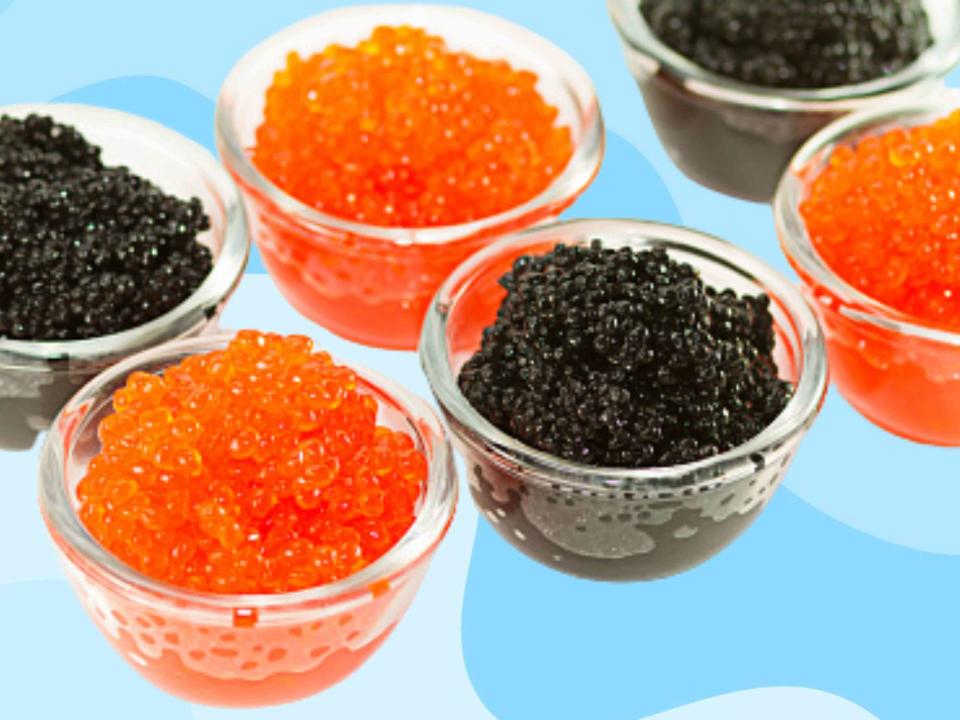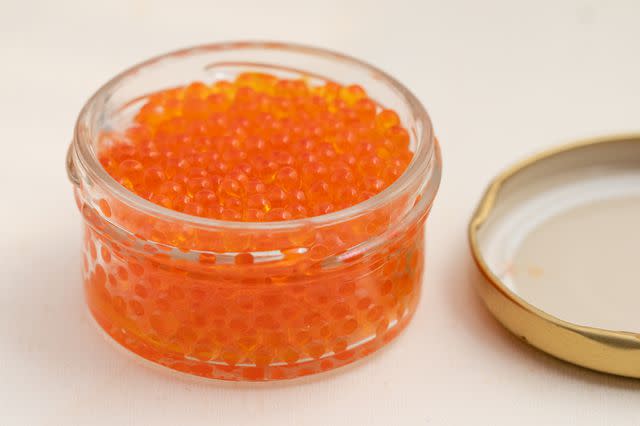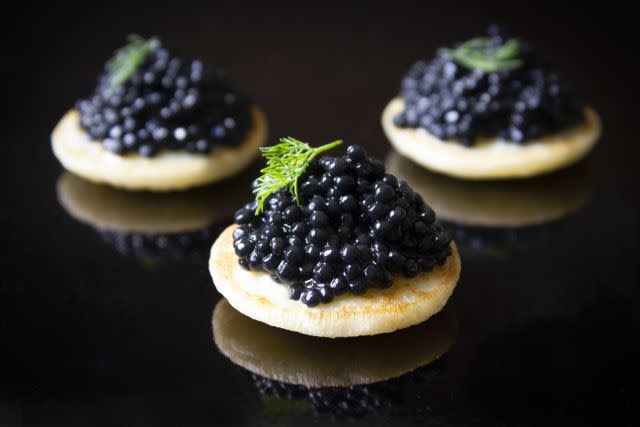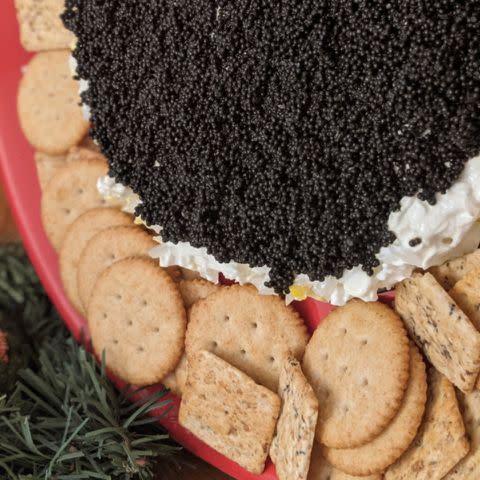What Is Caviar and Why Is It So Expensive?
Plus, what does it taste like?

lokisurina/Getty Images
Nothing says luxury quite like caviar. Pound for pound, it’s one of the most expensive ingredients in the world. Even just a few bites can set you back over $100. If you’ve ever indulged or are curious about trying caviar for the first time, you may have wondered, “What is caviar?”
Here’s what you need to know.
What Is Caviar?
Caviar is cured, unfertilized fish eggs. Technically, caviar refers to the cured eggs of sturgeon (a type of fish). Uncured eggs are called roe, but, over time, the word “caviar” has come to be used for several types of roe, even uncured and non-sturgeon varieties. The very small spheres range in color from bright orange to nearly black. They look like little beads covered in oil. Caviar is packed in small tins, usually between two and four ounces.
What Does Caviar Taste Like?
Caviar is well-loved for the "pop" of the egg bursting when it's chewed. The texture of the interior is often described as “buttery” and “velvety," as it coats your mouth and feels rich and decadent.
The flavor depends on the variety, but all caviar is generally salty and briny with a very sea-forward flavor profile. Unlike many other types of seafood, caviar is exceptionally savory and packed with meaty, umami flavors. It’s difficult to compare caviar to other foods, as part of what makes it so special is its unique essence. Caviar is complex; tasting many varieties will allow you to appreciate the subtle differences and nuances.

annick vanderschelden photography/Getty Images
What Fish Does Caviar Come From?
The most common type, the one most people mean by “caviar,” is sturgeon. However, roe from salmon and trout are sometimes referred to as caviar as well.
Sturgeon are large fish weighing over 1,000 pounds at maturity and can live to be 100 years old. There are almost 30 different types of sturgeon from which caviar can be harvested, but the most prized are Beluga, Kaluga, Ossetra, white sturgeon, and Sevruga.
Beluga caviar is the most valuable, but the demand for this luxurious product has led to overfishing, and the Beluga is now endangered. However, it's still harvested for caviar, causing the population to dwindle annually. Because of this, importing Beluga caviar into the U.S. is illegal, though many other countries still purchase and sell it.
Salmon, lumpfish, and trout roe are sometimes called caviar as well. All fish eggs are technically roe, but the delicate salting and curing process makes them caviar. These varieties are much, much cheaper than sturgeon. If you’ve never tried caviar and don’t want to shell out for it the first time, this is a good place to start, and it won’t break the bank. Tobiko, the roe from flying fish, is a common sushi topping and can be a fun introduction to fish eggs in general as it is small, mild, and inexpensive compared to caviar.
Where Does Caviar Come From?
Sturgeon caviar comes from several varieties of fish, usually found in the Caspian or Black Seas. Beluga caviar, the most expensive, can sometimes be found in the Adriatic Sea. Sturgeon can live in fresh or saltwater, so deltas and rivers from both seas harbor many types of sturgeon. Many countries border the Caspian and Black Seas, and they all, to some extent, participate in the fishing and harvesting of caviar, but the largest producers are Russia and Iran.
However, not all caviar comes from just this area. China is one of the largest producers of caviar in the world, with sturgeon from the Qiandao Lake in Zhejiang. Italy is known for its farmed caviar and is home to the largest sturgeon fishery in the world, located in Lombardy.

Synergee/Getty Images
Why Is Caviar So Expensive?
Even if you don’t know much about caviar, you probably know it’s expensive. Just one kilogram of rare albino sturgeon caviar from Iran sells for $34,000! This high price tag comes from several factors:
The first is the rarity of the fish. Wild sturgeon are endangered, and there are simply fewer fish to harvest now. Though farms exist, wild-caught caviar is more prized and thus more expensive.
Second, only female sturgeon can be harvested for eggs, so half the fish don’t produce caviar. Plus, because sturgeons live so long, it can take between 8 and 20 years for females to reach maturity.
Finally, harvesting practices are a major factor since they must be done by hand. Killing the fish is a less complicated and time-consuming method, but it can only be done once and decreases the number of fish. Live harvesting is possible, but it takes much more time, labor, and tools, which drives up the price.
How Much Does Caviar Cost?
The price of caviar can vary wildly depending on the type. If you’re in the market to buy a small 1-ounce tin of caviar for two people, expect to pay a minimum of about $75 for the lowest-quality sturgeon, but around $200 for some mid-tier caviar. Beluga is the most expensive, with prices ranging from $3,000 to $10,000 per pound. Roe from salmon, trout, or lumpfish (the closest variety to sturgeon) is more affordable and can be purchased for as little as $20.

What to Eat With Caviar
Due to its hefty price tag and unique flavor, caviar is best eaten alone. But not just any utensils will do: Caviar should be eaten off a mother of pearl, bone, or gold spoon. Metal flatware can greatly impact the flavor of the caviar, giving it an unpleasant metallic taste. Technically, plastic spoons are also acceptable, but caviar's luxury branding usually shies away from plastic cutlery.
There are a few common accompaniments for caviar that complement the flavor rather than overshadow it. Bellini, small yeasted pancakes from Russia, are an excellent platform for showcasing caviar. It’s also commonly paired with crème fraiche, butter, chives or shallots, and plain toast to showcase its flavor. Surprisingly, plain potato chips topped with a dollop of crème fraiche and studded with caviar is a common hors d'oeuvre served on New Year’s Eve—caviar pairs beautifully with Champagne.
How to Store Caviar
Caviar has a short shelf life and should be eaten right away. It is packaged in small, non-reactive metal tins, which helps to preserve it, and unopened, it will last a little over a month in the fridge. However, once the tin is opened, you should eat it immediately.
Technically, it’s safe to eat for three days after it’s opened, but the flavor degrades significantly. Caviar is best stored colder than your average refrigerator, so if possible, store it on ice in the coldest part of your fridge. Bring it to room temperature for just 5–10 minutes before serving, and avoid leaving any uneaten portions at room temperature.
Read the original article on All Recipes.


